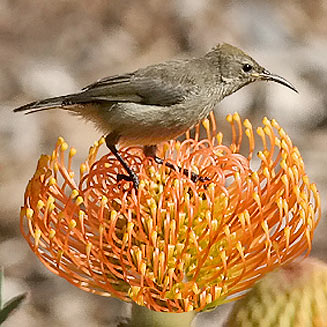|
Cinnyris chalybeus (Southern
double-collared sunbird, Lesser double-collared sunbird) .
[= Nectarinia chalybea]
Klein-rooibandsuikerbekkie [Afrikaans]; Ingcungcu (generic term
for sunbird) [Xhosa]; iNcuncu (also applied to Greater double-collared sunbird)
[Zulu]; Kleine kraaghoningzuiger [Dutch]; Souimanga chalybée [French];
Halsband-nektarvogel [German]; Beija-flor-de-banda-fina [Portuguese]
Life
> Eukaryotes >
Opisthokonta
> Metazoa (animals) >
Bilateria >
Deuterostomia > Chordata >
Craniata > Vertebrata (vertebrates) > Gnathostomata (jawed
vertebrates) > Teleostomi (teleost fish) > Osteichthyes (bony fish) > Class:
Sarcopterygii (lobe-finned
fish) > Stegocephalia (terrestrial
vertebrates) > Tetrapoda
(four-legged vertebrates) > Reptiliomorpha > Amniota >
Reptilia (reptiles) >
Romeriida > Diapsida > Archosauromorpha > Archosauria >
Dinosauria
(dinosaurs) > Saurischia > Theropoda (bipedal predatory dinosaurs) >
Coelurosauria > Maniraptora > Aves
(birds) >
Order: Passeriformes > Family: Nectariniidae
 |
 |
| Southern double-collared sunbird
male, Bot River, South Africa. [photo
Trevor Hardaker ©] |
Southern double-collared sunbird female,
Kirstenbosch Botanical Gardens, South Africa. [photo Trevor Hardaker ©] |
 |
 |
| Southern double-collared sunbird,
Tsitsikamma Nature Reserve, Western Cape, South Africa. [photo Duncan Robertson ©] |
Southern double-collared sunbird female on
Leucaspermum cordifolium. [photo
Jeff Poklen
©] |
Distribution and habitat
Endemic to southern Africa, occurring from the far south of
Namibia to South Africa, with the bulk of its population centered around the
Western Cape extending east and north to KwaZulu-Natal, Swaziland, Mpumalanga
and Limpopo Province. It generally prefers fynbos and Karoo shrubland, woodland,
Afromontane forest, gardens and Eucalyptus plantations.
|
 |
|
Distribution of Southern double-collared sunbird in southern Africa,
based on statistical smoothing of the records from first SA Bird Atlas
Project (©
Animal Demography unit, University of
Cape Town; smoothing by Birgit Erni and Francesca Little). Colours range
from dark blue (most common) through to yellow (least common).
See here for the latest distribution
from the SABAP2. |
Predators and parasites
The following animals have been recorded to feed on the
eggs and nestlings of the Southern double-collared sunbird:
Food
It mainly feeds on nectar, supplemented with athropods,
gleaning prey from vegetation and spider webs and hawking insects aerially. The following food items have been recorded
in its diet:
- Nectar
- Aloe
- Cadaba aphylla (Leafless wormbush)
- Calliandra (powder-puffs)
- Gladiolus
- Antholyza
- Canna
- Cotyledon orbiculare (Pig's ear)
- Erica
- Erythrina (coral-trees)
- Halleria lucida (Tree-fuchsia)
- Lachenalia (wild hyacinths)
- Microloma sagittatum (Bokhorings)
- Leucospermum (pincushions)
- Lobostemon fruticosus (Agdaegeneesbos)
- Leonotis (wild dagga)
- Lycium (honey-thorns)
- Phygelius capensis (Wild fuchsia)
- Protea
- Salvia
- Schotia afra (Karoo boer-bean)
- Tecoma capensis (Cape honeysuckle)
- Virgilia (keurbooms)
- Satyrium odorum (orchid)
- alien plants
- Callistemon viminalis (Weeping bottlebrush)
- Eucalyptus
- Lantana camara (Cherry-pie)
- Nicotiana glauca (Wild tobacco)
- Arthropods
Breeding
- The nest is built solely by the female in about 25-30 days, consisting of
an oval-shaped structure with a side entrance, built of grass, strands of
Old man's beard (Galium tomentosum), rootlets and twigs strongly
secured together with spider web. There are exceptions though, as some nests
(especially in forests) can be constructed entirely out of old-man's-beard (Usnea
barbata). It often decorates it with the fluffy seeds of Karoo
rosemaries (Eriocephalus) rarely along with bits of plastic, paper,
string or spider cocoons, while the interior is usually lined with wool,
plant down, feathers, fine bark shreds and soft grass seeds. It is typically
attached to a branch or incorporated into the foliage of a bush or tree,
occasionally in a mass of thorns or in a tent caterpillar nest.
- Egg-laying season is almost year-round, peaking from July-September.
- It lays 1-3 eggs, which are incubated solely by the female for about
13-16 days.
- The chicks are fed by both adults, leaving the nest after about 15-19
days, after which they continue to roost in the nest for about a week. The
parents feed them until they are about 42-46 days old, at which point the
young become fully independent.
Threats
Not threatened, in fact it has adapted well to the
introduction of man-made habitats such as gardens and plantations.
References
-
Hockey PAR, Dean WRJ and Ryan PG 2005. Roberts
- Birds of southern Africa, VIIth ed. The Trustees of the John Voelcker
Bird Book Fund, Cape Town.
|
